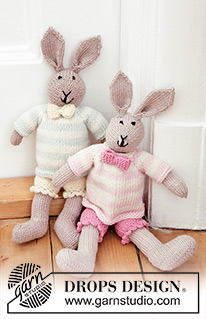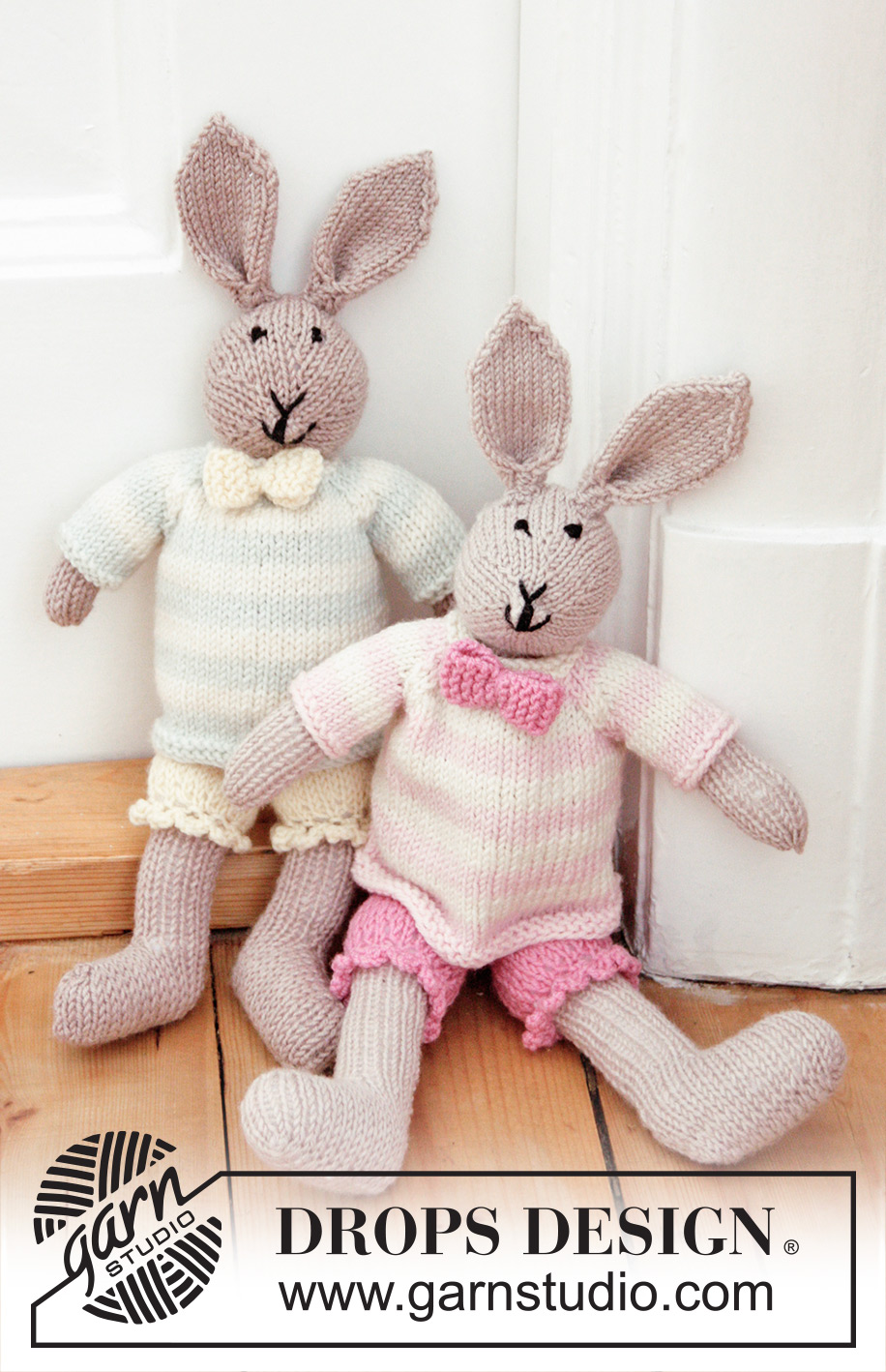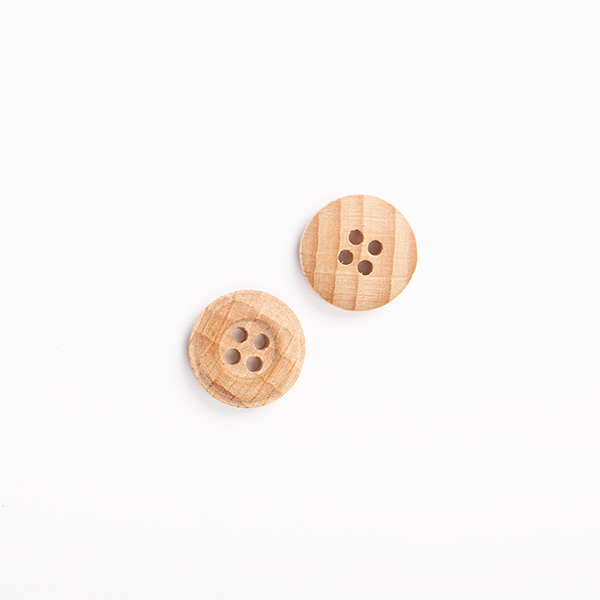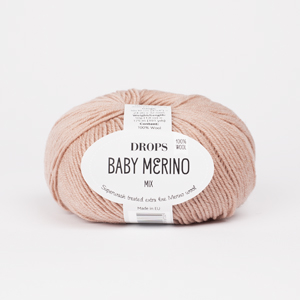Comments / Questions (45)
![]() Kristina Ek wrote:
Kristina Ek wrote:
Hej, hur stickar man tröjan tvetydigt hur man gör stickas både fram-o bakstycket i ett stycke o runt och hamnar skarven i sidan?, för när man stickar oket så står det att man börjar varvet mitt bak på fram-o bakstycket, det är ju mitt i stickningen?
30.05.2025 - 09:50DROPS Design answered:
Hei Kristina. Etter du har satt bolen og ermene sammen (uten at det strikkes), klipp tråden og start midt bak. mvh DROPS Design
02.06.2025 - 11:07
![]() Una wrote:
Una wrote:
Hi Is there a button hole row needed at back of jumper to secure the button? I don't see any mention of this in the pattern?
11.04.2025 - 01:36DROPS Design answered:
Dear Ana, there is no button hole, the button is sewn in both layers on back piece. Happy knitting!
11.04.2025 - 09:20
![]() Sigrun Dale wrote:
Sigrun Dale wrote:
Oppskrift på kanin, genser, sløyfe, men hvor er oppskrift på buksen?
07.04.2025 - 18:21DROPS Design answered:
Hei Sigrun, Buksa er strikket som en del av beina (de er ikke løse). God fornøyelse!
08.04.2025 - 06:58
![]() Vitaline wrote:
Vitaline wrote:
Bonjour,\r\nC’est le 1er ouvrage DROPS que je fais. Il a fallu que je me familiarise avec les explications. Le petit lapin est trop mighon. Je suis contente du résultat. Pour un 1er essai je l’ai fait avec une laine différente. Maintenant, je vais en faire un autre bien plus facilement avec la laine DROPS BABY MERINO que j’ai commandée. Merci beaucoup pour ce modèle adorable que j’ai eu envie de réussir et que j’ai réussi.👌❤️😘😘😘😘
06.04.2023 - 13:17
![]() Vitaline wrote:
Vitaline wrote:
Bonjour, Quand vous dites « 1 m lis au point mousse de chaque côté », cela veut dire : tricoter une maille endroit au début du rang et une maille endroit à la fin du rang ?
04.04.2023 - 07:31DROPS Design answered:
Bonjour Vitaline, cela veut dire - tricoter une maille endroit au début du rang et une maille endroit à la fin du rang, sur l'endroit et sur l'envers. Bon tricot!
04.04.2023 - 07:44
![]() Vitaline wrote:
Vitaline wrote:
Bonjour, JAMBE : RANG 1 (= sur l’endroit) 1 m lis au POINT MOUSSE. RANG 2 (= sur l’envers)) 1 m lis au POINT MOUSSE. Vous dites - voir ci-dessus - (où ?). Je ne comprends pas comme faire ces mailles lisières .
31.03.2023 - 15:00DROPS Design answered:
Bonjour Vitaline, pour tricoter au point mousse, on doit tricoter les mailles à l'endroit, autrement dit, sur l'endroit on tricote toutes les mailles à l'endroit, mais sur l'envers la 1ère et la dernière maille se tricotent à l'endroit (et les mailles jersey à l'envers). Dans cette vidéo, nous montrons comment tricoter en jersey avec 1 maille lisière au point mousse de chaque côté. Bon tricot!
11.04.2023 - 10:02
![]() Vitaline wrote:
Vitaline wrote:
Bonsoir,\r\nJe suis finalement arrivée à tricoter la tête. J’ai compris le montage avec les 6 premières mailles.\r\nPar contre, je trouve qu’au niveau des augmentations (jetés) mon travail n’est pas très net, il y a comme un petit trou. Pourtant je tricote bien la maille torse.\r\nJe vais recommencer.
27.03.2023 - 01:10
![]() Vitaline wrote:
Vitaline wrote:
Bonjour, Le rond magique se fait au crochet avec 6 premières mailles qui sont reprises aux aiguilles circulaires ? Merci pour votre réponse.
25.03.2023 - 06:57DROPS Design answered:
Bonjour Vitaline, non, les mailles sont bien montées aux aiguilles, cette vidéo devrait pouvoir vous aider. Bon tricot!
27.03.2023 - 09:04
![]() Zuzana wrote:
Zuzana wrote:
Geniálny návod, do detailu prepracovaný.
23.12.2022 - 21:09
![]() Janne Jacobsen wrote:
Janne Jacobsen wrote:
Jeg har købt garn og printet opskrift til Mr Bunny fra Ritos hjemmeside, men jeg synes der mangler opskrift på bukserne.
28.02.2022 - 07:33DROPS Design answered:
Hej Janne, jo bukserne starter på benet, der hvor du skifter til lys gul :)
02.03.2022 - 11:57
Mr. Bunny#dropsmrbunny |
|
 |
 |
Knitted bunny toy with pants, jumper and bow in DROPS BabyMerino
DROPS Baby 25-8 |
|
|
MAGIC CIRCLE: To avoid hole in the middle beg with this technique: Hold yarn end in the left hand and make a loop around left index finger (from left to right). Hold the loop with left thumb and index finger. Insert needle through loop, get yarn from ball (i.e. place yarn 1 time over needle from you), pull yarn back through loop, 1 YO (now place yarn from the back and towards you) and pull YO through sts on needle, * insert needle through loop, 1 YO (place yarn from the back and towards you), pull YO through loop, 1 YO (from the back and towards you) and pull YO through outermost st on right needle (i.e. the last st made) *, repeat from *-* until there are 6 sts on needle. Then work as explained in pattern – AT THE SAME TIME pull yarn end so that loop is tighten tog and the hole disappears. INCREASE TIP: Inc 1 st by making 1 YO. On next round/row work YO twisted to avoid holes. GARTER ST (back and forth on needle): K all rows. 1 ridge = K2 rows. STRIPES: * 4 rounds/rows light mint, 4 rounds/rows off white *, repeat from *-*. ---------------------------------------------------------- HEAD: Worked in the round on double pointed needles from snout and back. Make a MAGIC CIRCLE with light beige - see explanation above = 6 sts on needle. Distribute sts on 3 double pointed needles size 3 mm / US 2.5 (work with fourth needle) and work in the round as follows: ROUND 1: K all sts. ROUND 2: * K 1, 1 YO *, repeat from *-* the entire round = 12 sts. ROUND 3: K all sts (always K YOs twisted to avoid holes). ROUND 4: * K 2, 1 YO *, repeat from *-* the entire round = 18 sts. ROUND 5: K all sts. ROUND 6: * K 3, 1 YO *, repeat from *-* the entire round = 24 sts. ROUND 7: K all sts. ROUND 8: * K 4, 1 YO *, repeat from *-* the entire round = 30 sts. ROUND 9: K all sts. ROUND 10: * K 5, 1 YO *, repeat from *-* the entire round = 36 sts. ROUND 11-12: K all sts = 36 sts. Insert 1 marker after the first 3 sts at beg of round and 1 marker after another 6 sts. Then inc 1 st inside the 2 markers - READ INCREASE TIP (= 2 sts inc). Repeat inc every other round 2 more times (= 3 inc in total in each side) = 42 sts. ROUND 18-19: K all sts = 42 sts. ROUND 20: * K 5, K 2 tog *, repeat from *-* the entire round = 36 sts. ROUND 21: K all sts. ROUND 22: * K 4, K 2 tog *, repeat from *-* the entire round = 30 sts. ROUND 23: K all sts. Continue dec like this on every other round (i.e. on every round with dec work 1 st less before working 2 sts tog = 6 sts dec per round) until 12 sts remain on needle, cut the yarn and pull it through sts on needle (without tightening). Embroider eyes, mouth and snout with black, fill the head with poly stuffing, tighten tog sts and fasten (= mid back of head). EAR: Worked in the round from bottom up. Cast on 8 sts with light beige and distribute sts on 2 double pointed needles (work with third needle). ROUND 1-2: K all sts. ROUND 3: * K 1, 1 YO, K 2, 1 YO, K 1 *, repeat from *-* 1 more time = 12 sts on needle. ROUND 4: K all sts (always K YOs twisted to avoid holes). ROUND 5: * K 1, 1 YO, K 4, 1 YO, K 1 *, repeat from *-* 1 more time = 16 sts on needle. ROUND 6: K all sts. ROUND 7: * K 1, 1 YO, K 6, 1 YO, K 1 *, repeat from *-* 1 more time = 20 sts on needle. Then work in stockinette st in the round until piece measures approx. 5½ cm / 2¼". Then dec as follows: ROUND 1: * Slip 1 st as if to K, K 1, psso, K 6, K 2 tog *, repeat from *-* 1 more time = 16 sts. ROUND 2: K all sts. ROUND 3: * Slip 1 st as if to K, K 1, psso, K 4, K 2 tog *, repeat from *-* 1 more time = 12 sts. ROUND 4: K all sts. Continue dec like this every other round until 4 sts remain on needle (i.e. on every round with dec work 2 sts less between dec in each side). On next round K2 tog around. Cut the yarn and pull it through sts, tighten tog and fasten. Fold each side at the bottom of ear towards the middle so that a pleat is formed in the mid of ear. Sew tog at the bottom with a couple of stitches and fasten ear on head. Work another ear the same way. BODY: Worked in the round, top down. Cast on 16 sts with light beige and distribute sts on 4 double pointed needles (work with fifth needle). ROUND 1-2: K all sts. ROUND 3: * K 2, 1 YO *, repeat from *-* the entire round = 24 sts. ROUND 4: K all sts (always K YOs twisted to avoid holes). ROUND 5: * K 2, 1 YO *, repeat from *-* the entire round = 36 sts. ROUND 6: K all sts. ROUND 7: * K 3, 1 YO *, repeat from *-* the entire round = 48 sts. Then work in stockinette st in the round until piece measures 5½ cm / 2¼". Switch to light yellow and K 1 round and P 1 round. Then work 8 rounds in stockinette st. Continue to dec as follows: ROUND 1: * K 6, K 2 tog *, repeat from *-* the entire round = 42 sts. ROUND 2: K all sts. ROUND 3: * K 5, K 2 tog *, repeat from *-* the entire round = 36 sts. ROUND 4: K all sts. Continue dec like this on every other round (i.e. on every round with dec work 1 st less before working 2 sts tog = 6 sts dec per round) until 12 sts remain on needle, cut the yarn and pull it through sts on needle (without tightening). Fill body with poly stuffing, tighten tog sts on yarn and fasten. Sew head to body (light yellow should be down (= pants)). LEG: Worked back and forth, bottom up. Cast on 30 sts on double pointed needles size 3 mm / US 2.5 with light beige. Work in stockinette st back and forth for 3 cm / 1". Then work as follows: ROW 1 (= RS): 1 edge st in GARTER ST – see explanation above, K 10, K2 tog 4 times, K 10 and 1 edge st in garter st = 26 sts. ROW 2 (= WS): 1 edge st in garter st, P 5, bind off the next 14 sts, P 5 and 1 edge st in garter st = 6 sts remain in each side. ROW 3 (= RS): Work the first 6 sts on needle and then the next 6 sts on needle (the 14 bind off sts form a hole in the mid of piece). Then work in stockinette st back and forth over the 12 sts with 1 edge st in garter st in each side until leg measures approx. 8 cm / 3". Switch to light yellow, K 1 row from RS and K 1 row from WS. Then work as follows: ROW 1 (= RS): * K 1, 1 YO *, repeat from *-* until 1 st remains and finish with K 1 = 23 sts. ROW 2 (= WS): P but K edge sts in each side and P YOs twisted to avoid holes. ROW 3: * K 2, 1 YO *, repeat from *-* until 1 st remains and finish with K 1 = 34 sts. Then work in stockinette st back and forth with 1 edge st in garter st in each side until leg measures approx. 12 cm / 4¾", bind off. Sew opening mid on top of foot with grafting/kitchener sts. Sew foot tog mid under and continue up along mid back - sew in front loop of outermost st. Fill leg with some poly stuffing. Baste a strand up and down through bind-off edge at the top of leg (on the yellow). Tighten tog to make it baggy. Work another leg the same way and fasten both legs on body. LACE EDGE Crochet a lace edge on hook size 3 mm / C with light yellow at the bottom around pants on each leg as follows (crochet in P sts): 1 sc in first st, * ch 4, 1 dc in 4th ch from hook, 1 sc in next P st on pants *, repeat from *-* the entire round and finish with 1 sl st in first sc from beg of round. Fasten off. ARM: Work back and forth on double pointed needles from top and down. Cast on 10 sts with light beige and work in stockinette st back and forth with 1 edge st in garter st in each side until arm measures 9 cm / 3½". Cut the yarn (make it long enough to use for sewing the arm tog), pull yarn through sts on needle (= at the bottom of arm), tighten tog and then sew arm tog in front loop of outermost st. Fill arm with poly stuffing and fasten at the top of body by neck (below the head). Work another arm the same way and fasten in the opposite side. JUMPER: Piece is worked in the round on double pointed needles up to armhole, then work back and forth on needle. BODY: Cast on 60 sts with light mint. P 1 round, K 1 round and P 1 round. Then work in stockinette st and STRIPES - see explanation above. When piece measures approx. 9 cm / 3½" – adjust so that last round in a stripe with light mint remains, work next round as follows: bind off 6 sts for armhole, work 24 sts, bind off the next 6 sts for armhole and work the last 24 sts. Put piece aside and knit the sleeves. SLEEVE: Worked in the round on double pointed needles. Cast on 20 sts with light mint. K 1 round and P 1 round. Then work in stockinette st and STRIPES in the round. When 11 rounds with stripes have been worked (i.e. last round in a stripe with light mint remains), work next round as follows: bind off 6 sts for armhole and work the remaining 14 sts. Cut the yarn, put piece aside and Make another sleeve. YOKE: Slip sleeves on to same needle as body where armholes were bound off (without working them first) = 76 sts on needle. Beg round from RS mid back on body and continue stripes as follows (1st round = off white): ROUND 1: 1 edge st in garter st, K 9, K 2 tog, K 2 twisted tog, K 10 (= sleeve), K 2 tog, K 2 twisted tog, K 20 (= front), K 2 tog, K 2 twisted tog, K 10 (= sleeve), K 2 tog, K 2 twisted tog, K 9 and 1 edge st in garter st = 68 sts. Then work back and forth from mid back. ROW 2 (= WS): P but work edge sts in garter st. ROW 3 (= RS): 1 edge st in garter st, K 8, K 2 tog, K 2 twisted tog, K 8 (= sleeve), K 2 tog, K 2 twisted tog, K 18 (= front), K 2 tog, K 2 twisted tog, K 8 (= sleeve), K 2 tog, K 2 twisted tog, K 8 and 1 edge st in garter st = 60 sts. ROW 4 (= WS): P but work edge sts in garter st. ROW 5 (= RS): Switch to light mint and work 1 edge st in garter st, K 7, K 2 tog, K 2 twisted tog, K 6 (= sleeve), K 2 tog, K 2 twisted tog, K 16 (= front), K 2 tog, K 2 twisted tog, K 6 (= sleeve), K 2 tog, K 2 twisted tog, K 7 and 1 edge st in garter st = 52 sts. ROW 6 (= WS): P but work edge sts in garter st. ROW 7 (= RS): 1 edge st in garter st, K 6, K 2 tog, K 2 twisted tog, K 4 (= sleeve), K 2 tog, K 2 twisted tog, K 14 (= front), K 2 tog, K 2 twisted tog, K 4 (= sleeve), K 2 tog, K 2 twisted tog, K 6 and 1 edge st in garter st = 44 sts. ROW 8 (= WS): P but work edge sts in garter st. Switch to off white and work next row as follows: 1 edge st in garter st, * K 1, K 2 tog *, repeat from *-* until 1 st remains and finish with 1 edge st in garter st = 30 sts. K 1 row from WS, K 1 row from RS and K 1 row from WS before binding off with K from RS. Fasten off. BOW: Cast on 5 sts on double pointed needles size 3 mm / US 2.5 with light yellow. Work in garter st back and forth for 8 cm / 3", bind off. Sew short sides tog in front loop of outermost st to form a ring. Fasten off. Find a new strand, wind it a couple of times around the middle of bow and fasten bow in the neck on jumper. Put the jumper on the bunny and fasten the button through both layers at the top of neck at the back. |
|
Have you finished this pattern?Tag your pictures with #dropspattern #dropsmrbunny or submit them to the #dropsfan gallery. Do you need help with this pattern?You'll find 29 tutorial videos, a Comments/Questions area and more by visiting the pattern on garnstudio.com. © 1982-2025 DROPS Design A/S. We reserve all rights. This document, including all its sub-sections, has copyrights. Read more about what you can do with our patterns at the bottom of each pattern on our site. |
|




































































Post a comment to pattern DROPS Baby 25-8
We would love to hear what you have to say about this pattern!
If you want to leave a question, please make sure you select the correct category in the form below, to speed up the answering process. Required fields are marked *.